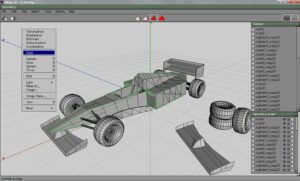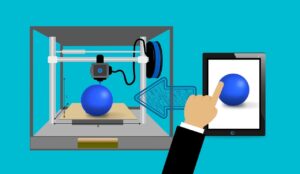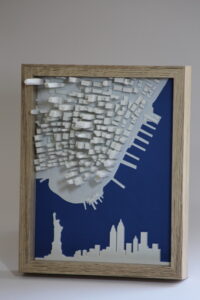3D modeling has changed the game in many industries. It lets designers, architects, and animators bring their ideas to life in a virtual space. Plus, it can be used to fine-tune intricate details, textures, and dimensions. As a result, this technology creates accurate and realistic visualizations.
It’s also used in the medical field for surgical planning and simulation. Surgeons can create 3D models of patients’ organs or body parts. This helps them practice complex procedures and evaluate potential outcomes. Plus, it increases patient safety and improves communication between surgical teams.
3D modeling has even made a splash in archaeology. Researchers use it to create virtual replicas of ancient artifacts or structures. This helps them analyze and interpret important objects without causing damage. Ultimately, it helps preserve the original for future generations.
Entertainment is another industry that’s leveraging 3D modeling. It creates immersive experiences for audiences. From games to movies, realistic characters and environments help tell stories. Plus, 3D modeling adds detail and depth to visual effects, creating a captivating audience experience.
When working with 3D models, make sure to use compatible file formats like .obj or .fbx. This will ensure smooth collaboration with other professionals on the project.
In conclusion, 3D modeling is important in many industries. It’s being used in medicine, archaeology, and entertainment. By taking advantage of this tech, professionals open up lots of possibilities for creativity and problem-solving.
Exploring the Applications of Free 3D Models
Discover the amazing possibilities of free 3D models! From architecture to gaming, they have revolutionized a range of industries. Designers gain access to resources that save them time and effort. Plus, they bring unique details to projects without requiring extensive resources or specialized skills.
| Industry | Application |
| Architecture | Realistic visualizations for buildings and structures. |
| Manufacturing | Rapid prototyping and quick iterations in product development. |
| Gaming | Immersive environments and characters. |
| Film and Animation | Detailed elements and special effects. |
The history of free 3D models is exciting. They began as niche tools in the early days of computer graphics. As technology advanced, the quality and availability of these models grew. Now, they are an important part of many industries, providing design expertise all over the world.
Benefits and Limitations of Free 3D Models
Free 3D models provide a cost-effective solution for professionals. They enable widespread adoption and foster innovation in various fields. Benefits include rapid prototyping and experimentation without upfront costs. Additionally, they can be used as creative inspiration and a starting point for further customization. These models also promote collaboration within the industry as users share their creations with others.
Notably, NASA utilizes free 3D models to inspire students’ interest in space exploration. They partner with Sketchfab to offer an extensive collection of downloadable spacecraft models created by engineers and designers. This initiative provides accurate representations of iconic vehicles and encourages learners to explore STEM subjects.
Case Studies of Innovative Applications
Automotive industry? 3D modeling has changed the game. Virtual models make production more efficient and cost-effective, while improving car quality.
Architects too use free models to better visualize projects before construction. This helps to catch and fix issues, saving time and money.
Healthcare? Realistic 3D models help surgeons plan complex surgeries with more accuracy. This reduces risks and raises success rates, improving patient outcomes.
When using free models, think scalability and workflow compatibility. Models that fit your needs will give the best results.
Challenges and Future Developments in Free 3D Modeling
Free 3D modeling has its own issues and opportunities. A major problem is the complex software, which is hard for beginners to learn. Also, there are not many good quality free models. Developers are trying to make user interfaces easier and to produce more diverse and realistic free models.
This table shows the challenges and future developments:
| Challenge | Future Development |
|---|---|
| Complex Software | User-friendly interfaces |
| Limited Free Models | More diverse and realistic free model libraries |
Artificial intelligence and virtual reality may also help. This could revolutionize the way we create and use 3D models.
In the past, free 3D modeling software was rare. It was hard for people to find affordable tools. But now, because of advances in technology and open-source initiatives, many free 3D modeling software options are available. This has made the creative process easier for everyone.
Conclusion and Takeaways
The 3D modeling world keeps advancing with fresh applications and free models. We can see these developments have revolutionized industries like architecture, gaming, and virtual reality.
One takeaway from this exploration is the multi-functionality of free models. Architects can add detailed 3D renderings to their plans for clients to visualize the space before construction. Likewise, game developers can utilize pre-made 3D assets while still making visually attractive games.
The accessibility of free models has also made virtual reality more inclusive. Creators don’t need coding skills or budgets to create immersive experiences. This gives designers from all backgrounds a chance to join the growing VR industry.
It’s important to remember copyright and licensing when using free models. We must follow usage restrictions set by the original creators, to keep a fair and ethical environment for sharing and using these models.
Frequently Asked Questions
1. What is 3D modeling and why is it important?
3D modeling is the process of creating a three-dimensional representation of an object or scene using specialized software. It is important because it allows designers, architects, and artists to visualize and bring their ideas to life in a realistic and immersive manner.
2. Can I use free models for commercial purposes?
It depends on the specific licensing terms of the free models. Some free model repositories offer models that can be used for commercial purposes, while others may have restrictions on commercial use. Always make sure to review the licensing information before using free models for commercial projects.
3. Where can I find free 3D models?
There are several websites where you can find free 3D models, such as Sketchfab, Thingiverse, and TurboSquid. These platforms offer a wide range of models created by talented artists and designers from around the world.
4. What are some innovative applications of free 3D models?
Free 3D models can be used in various innovative applications such as virtual reality (VR) experiences, video games, architectural visualization, product design, and even in medical simulations. They provide a cost-effective solution for creating immersive and realistic digital content.
5. Is it difficult to learn 3D modeling?
Learning 3D modeling can be challenging, especially for beginners. However, with the right resources and practice, anyone can learn how to create 3D models. There are various online tutorials, courses, and communities available that can help you get started and improve your skills.
6. Can I modify and customize free 3D models to suit my project?
In most cases, yes. Free 3D models are often provided in formats that can be easily modified and customized using 3D modeling software. However, it is important to always check the licensing terms to ensure that the specific model allows for modifications and derivative works.



